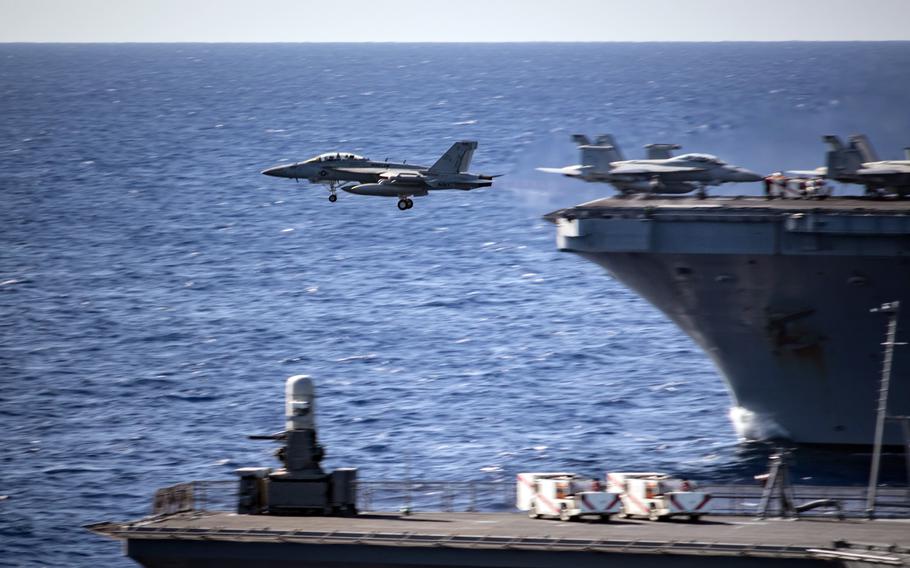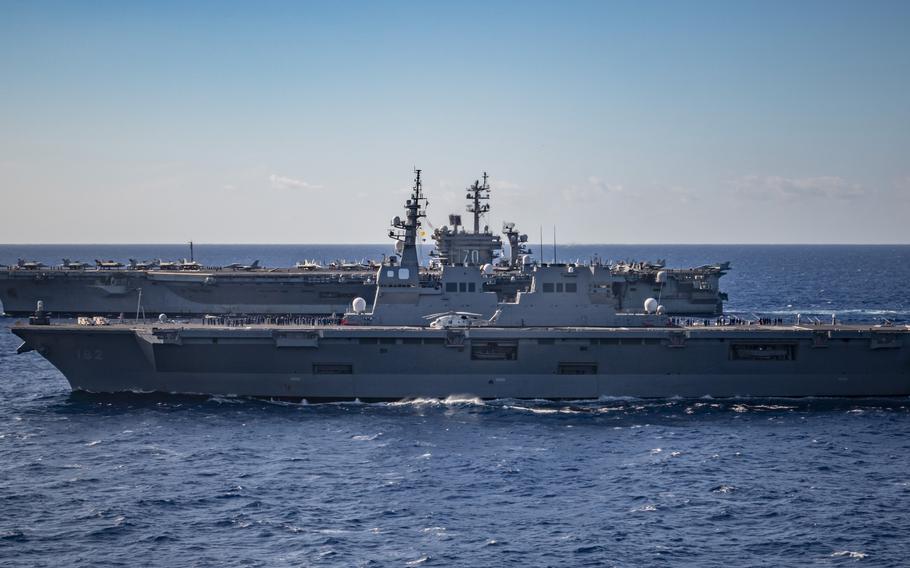
An F/A-18E Super Hornet assigned to Carrier Air Wing 2 takes off from the aircraft carrier USS Carl Vinson in the Philippine Sea, Jan. 31, 2024. (Robert Hicks/U.S. Navy)
YOKOSUKA NAVAL BASE, Japan — Two Navy carrier strike groups and a Japanese helicopter destroyer met in the Philippine Sea this week for three days of training, an increasingly common practice by the U.S. and its allies.
The USS Carl Vinson and USS Theodore Roosevelt, their respective strike groups and Japan’s JS Ise met Tuesday for what the Navy called a “multi-large deck event,” the U.S. 7th Fleet said in a statement late Wednesday.
The armada consisted of at least 12 ships, including seven guided-missile destroyers and two guided-missile cruisers, according to the statement.
“Along with the Japan Maritime Self-Defense Force, our ships and aircraft conducted air defense drills, sea surveillance, cross-deck exercises and tactical maneuvers to advance unique high-end warfighting capability,” Carrier Strike Group 1 spokeswoman Lt. Cmdr. Devin Arneson told Stars and Stripes by email Thursday.
Such training is “critical to regional security and stability” and helps keep the Pacific’s bustling sea lanes open, she said.
Arneson, citing security concerns, declined to provide further details on the exercise, including its precise location. The Philippine Sea extends south of Japan’s main islands and east of Taiwan.
Drills involving two U.S. aircraft carriers were once considered a rarity; Tuesday’s event was at least the third in four months.

The aircraft carrier USS Carl Vinson sails alongside the Japanese helicopter destroyer JS Ise in the Philippine Sea, Jan. 31, 2024. (Robert Hicks/U.S. Navy)
The Gerald R. Ford and Dwight D. Eisenhower strike groups trained together Nov. 1-3 in the Mediterranean Sea. On Nov. 4, the Carl Vinson and Ronald Reagan carrier strike groups began their own multiday exercise with the Japanese helicopter carrier JS Hyuga in the Philippine Sea.
The Navy, however, emphasized the routine nature of this week’s joint training.
“What is special about our operations here today is that they are not unusual for us,” Arneson said. The Navy regularly brings together a variety of ships and capabilities for large-scale exercises, she said.
Arneson cited joint training last month by the Carl Vinson, JS Ise and JS Hyuga, and November’s dual-carrier drill, as examples.
“This exercise demonstrates the power of our friends, partners and allies by our side committed to a shared vision of a free and open Indo-Pacific,” she said.
This week’s exercise was the result of “a lot of high-level, detailed coordination” between the U.S. and Japan, and not a response to any other event, Arneson said.
Taiwan’s military began its own military exercise Tuesday, the first since the island’s Jan. 13 presidential elections.
China, which considers Taiwan a breakaway province, has increased pressure on the self-ruling island following the election.
Beijing routinely sends several aircraft and vessels toward the island daily. Over the past several weeks, those numbers have sporadically increased to dozens on some days.
China as of Thursday had not publicly commented on the U.S.-Japan drill.